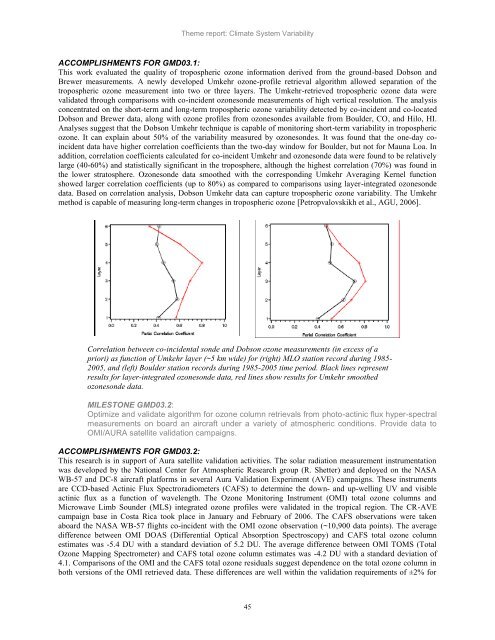Scientific Theme: Advanced Modeling and Observing Systems
Scientific Theme: Advanced Modeling and Observing Systems
Scientific Theme: Advanced Modeling and Observing Systems
Create successful ePaper yourself
Turn your PDF publications into a flip-book with our unique Google optimized e-Paper software.
<strong>Theme</strong> report: Climate System Variability<br />
ACCOMPLISHMENTS FOR GMD03.1:<br />
This work evaluated the quality of tropospheric ozone information derived from the ground-based Dobson <strong>and</strong><br />
Brewer measurements. A newly developed Umkehr ozone-profile retrieval algorithm allowed separation of the<br />
tropospheric ozone measurement into two or three layers. The Umkehr-retrieved tropospheric ozone data were<br />
validated through comparisons with co-incident ozonesonde measurements of high vertical resolution. The analysis<br />
concentrated on the short-term <strong>and</strong> long-term tropospheric ozone variability detected by co-incident <strong>and</strong> co-located<br />
Dobson <strong>and</strong> Brewer data, along with ozone profiles from ozonesondes available from Boulder, CO, <strong>and</strong> Hilo, HI.<br />
Analyses suggest that the Dobson Umkehr technique is capable of monitoring short-term variability in tropospheric<br />
ozone. It can explain about 50% of the variability measured by ozonesondes. It was found that the one-day coincident<br />
data have higher correlation coefficients than the two-day window for Boulder, but not for Mauna Loa. In<br />
addition, correlation coefficients calculated for co-incident Umkehr <strong>and</strong> ozonesonde data were found to be relatively<br />
large (40-60%) <strong>and</strong> statistically significant in the troposphere, although the highest correlation (70%) was found in<br />
the lower stratosphere. Ozonesonde data smoothed with the corresponding Umkehr Averaging Kernel function<br />
showed larger correlation coefficients (up to 80%) as compared to comparisons using layer-integrated ozonesonde<br />
data. Based on correlation analysis, Dobson Umkehr data can capture tropospheric ozone variability. The Umkehr<br />
method is capable of measuring long-term changes in tropospheric ozone [Petropvalovskikh et al., AGU, 2006].<br />
Correlation between co-incidental sonde <strong>and</strong> Dobson ozone measurements (in excess of a<br />
priori) as function of Umkehr layer (~5 km wide) for (right) MLO station record during 1985-<br />
2005, <strong>and</strong> (left) Boulder station records during 1985-2005 time period. Black lines represent<br />
results for layer-integrated ozonesonde data, red lines show results for Umkehr smoothed<br />
ozonesonde data.<br />
MILESTONE GMD03.2:<br />
Optimize <strong>and</strong> validate algorithm for ozone column retrievals from photo-actinic flux hyper-spectral<br />
measurements on board an aircraft under a variety of atmospheric conditions. Provide data to<br />
OMI/AURA satellite validation campaigns.<br />
ACCOMPLISHMENTS FOR GMD03.2:<br />
This research is in support of Aura satellite validation activities. The solar radiation measurement instrumentation<br />
was developed by the National Center for Atmospheric Research group (R. Shetter) <strong>and</strong> deployed on the NASA<br />
WB-57 <strong>and</strong> DC-8 aircraft platforms in several Aura Validation Experiment (AVE) campaigns. These instruments<br />
are CCD-based Actinic Flux Spectroradiometers (CAFS) to determine the down- <strong>and</strong> up-welling UV <strong>and</strong> visible<br />
actinic flux as a function of wavelength. The Ozone Monitoring Instrument (OMI) total ozone columns <strong>and</strong><br />
Microwave Limb Sounder (MLS) integrated ozone profiles were validated in the tropical region. The CR-AVE<br />
campaign base in Costa Rica took place in January <strong>and</strong> February of 2006. The CAFS observations were taken<br />
aboard the NASA WB-57 flights co-incident with the OMI ozone observation (~10,900 data points). The average<br />
difference between OMI DOAS (Differential Optical Absorption Spectroscopy) <strong>and</strong> CAFS total ozone column<br />
estimates was -5.4 DU with a st<strong>and</strong>ard deviation of 5.2 DU. The average difference between OMI TOMS (Total<br />
Ozone Mapping Spectrometer) <strong>and</strong> CAFS total ozone column estimates was -4.2 DU with a st<strong>and</strong>ard deviation of<br />
4.1. Comparisons of the OMI <strong>and</strong> the CAFS total ozone residuals suggest dependence on the total ozone column in<br />
both versions of the OMI retrieved data. These differences are well within the validation requirements of ±2% for<br />
45
















